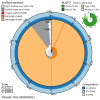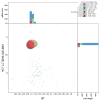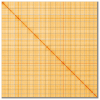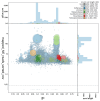The chromosomal genome sequence of the sponge Crambe crambe (Schmidt, 1862) and its associated microbial metagenome sequences
- PMID: 40520149
- PMCID: PMC12166358
- DOI: 10.12688/wellcomeopenres.24154.1
The chromosomal genome sequence of the sponge Crambe crambe (Schmidt, 1862) and its associated microbial metagenome sequences
Abstract
We present a genome assembly from an individual Crambe crambe (Porifera; Demospongiae; Poecilosclerida; Crambeidae). The host genome sequence is 143.20 megabases in span. Most of the assembly is scaffolded into 18 chromosomal pseudomolecules. The mitochondrial genome has also been assembled and is 19.53 kilobases in length. Several symbiotic prokaryotic genomes were assembled as MAGs, including two relevant sponge symbionts, the Candidatus Beroebacter blanensis/ AqS2 clade (Tethybacterales, Gammaproteobacteria) of LMA sponges, and the widely distributed archaeal Nitrosopumilus sp. clade.
Keywords: Crambe crambe; Poecilosclerida; chromosomal; genome sequence; marine sponge.
Copyright: © 2025 Maldonado M et al.
Conflict of interest statement
No competing interests were disclosed.
Figures







Similar articles
-
The chromosome-level genome sequences of the freshwater sponge, Spongilla lacustris (Linnaeus, 1759) and the chlorophyte cobiont Choricystis sp., and the associated microbial metagenome sequences.Wellcome Open Res. 2025 Apr 25;10:222. doi: 10.12688/wellcomeopenres.23988.1. eCollection 2025. Wellcome Open Res. 2025. PMID: 40487152 Free PMC article.
-
Microbiome changes through the ontogeny of the marine sponge Crambe crambe.Environ Microbiome. 2024 Mar 11;19(1):15. doi: 10.1186/s40793-024-00556-7. Environ Microbiome. 2024. PMID: 38468324 Free PMC article.
-
The chromosomal genome sequence of the kidney sponge, Chondrosia reniformis Nardo, 1847, and its associated microbial metagenome sequences.Wellcome Open Res. 2025 May 29;10:283. doi: 10.12688/wellcomeopenres.24166.1. eCollection 2025. Wellcome Open Res. 2025. PMID: 40548332 Free PMC article.
-
The chromosomal genome sequence of the marine leech, Branchellion lobata Moore, 1952 and its associated microbial metagenome sequences.Wellcome Open Res. 2025 Jun 2;10:304. doi: 10.12688/wellcomeopenres.24186.1. eCollection 2025. Wellcome Open Res. 2025. PMID: 40771652 Free PMC article.
-
Batzella, Crambe and Monanchora: Highly Prolific Marine Sponge Genera Yielding Compounds with Potential Applications for Cancer and Other Therapeutic Areas.Nutrients. 2018 Jan 2;10(1):33. doi: 10.3390/nu10010033. Nutrients. 2018. PMID: 29301302 Free PMC article. Review.
References
-
- Becerro MA, Uriz MJ, Turón X: Trends in space occupation by the encrusting sponge Crambe crambe: variation in shape as a function of size and environment. Mar Biol. 1994;121:301–307. 10.1007/BF00346738 - DOI
LinkOut - more resources
Full Text Sources

